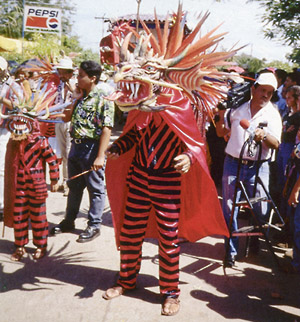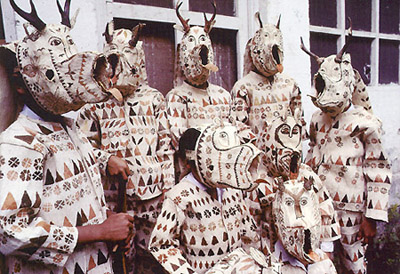 |
 |
| Devils at patron saint
festival "La Mejorana" in Guararé, in the province of Herrea. Photo by Stuart G.R. Warner W. "Panama Now" 1997 |
|
Diablicos Sucios The devil dances have their origin in European masques. Especially after the plague, the macabre and the devil were themes for many celebrations. In the case of the devil dances in Panama, they all serve a religious purpose: the evangelization of the other. So they came to be a vivid image of the battle between good and evil that promoted conversion. Most of the devil dances are usually practiced for the religious feast of Corpus Christi, that celebrates the presence of Jesus in the host. These practices are colonial, but there are no dates that we can specify as to when or where they started. Most probably very early in the 16th century.
The Diablicos Sucios (shown above and
below) are the ones from Los
Santos and Chitre. They wear red and black stripped suits that
originally were painted with charcoal and "achiote" over
cotton "manta sucia" and carried an animal bladder that
usually stank; when they danced and sweated the colors ran off making
a dirty look-hence the name "sucios". The cone that they use to hold the mask
is beautifully decorated with red guacamaya feathers. They also use castanets
and a stick. There is no narrative sequence in this dance.
The Diablos Limpios (or la Danza del
Grandiablo) (below) from La Villa, Chorrera, and Chitre, is the most
Europeanized version. The dress consists of devil masks and a white dress and pants
decorated with multicolored satin handkerchiefs and bells. The dance
is a religious drama with several designated characters (El
Grandiablo, Diablo Capitan, La Diabla, Caracolito, the Sould and St.
Michael) in which the devil and his troop fight with St. Michael for
the possession of a human soul. It is celebrated on Corpus Christi.
The Diablos Espejos (below) from Colon are usually
dressed in black or red. The origin of the dance is European but has definitely
acquired African elements. The black population that
practices this is not West Indian, but is what has been called
Afro-colonial which defines the black population that came under the
Spanish colonial system as slaves, way before the West Indians came to
build the canal. They practice it around carnivals and the dance
includes an interesting episode where the devil is baptized.
There are other devil dances around
the country like the Cucua (below) in Cocle, who make costumes from the cucua
tree bark and deer horns.
|
 |
| A sight seldom seen - a group
of Cucuá folklore dancers from Chiguiri Arriba, a remote area of the
provice of Cocle. Their costumes are made from the bark of the
cucuá tree. Photo by Stuart G.R. Warner W. "Panama Now" 1997 |
In addition to those above, there are Corpus Christi dances practiced in the island of San Miguel, on Las Perlas archipelago. There is dance with with the men dressed in grass skirts called the Zaracundi, also practiced by Afro-coloniales runaway slaves. Another one with skirts that stand open with wire is called La Montezuma Espaqola and is a catholic play based on the conquest of Mexico. Both dances are from the Corpus Christi of La Villa, province of Los Santos. I will try and get photos of the last mentioned groups. |
Home|
Photo
of the Week | Photo
Archives | Main
Show Room | Photo
Room | Military
History
PC
History | Sign
Guest Book | Read
Guest Book | Search
CZ Images | CZ
Web Searcher
Gift
Shop | Book
Store | Links
